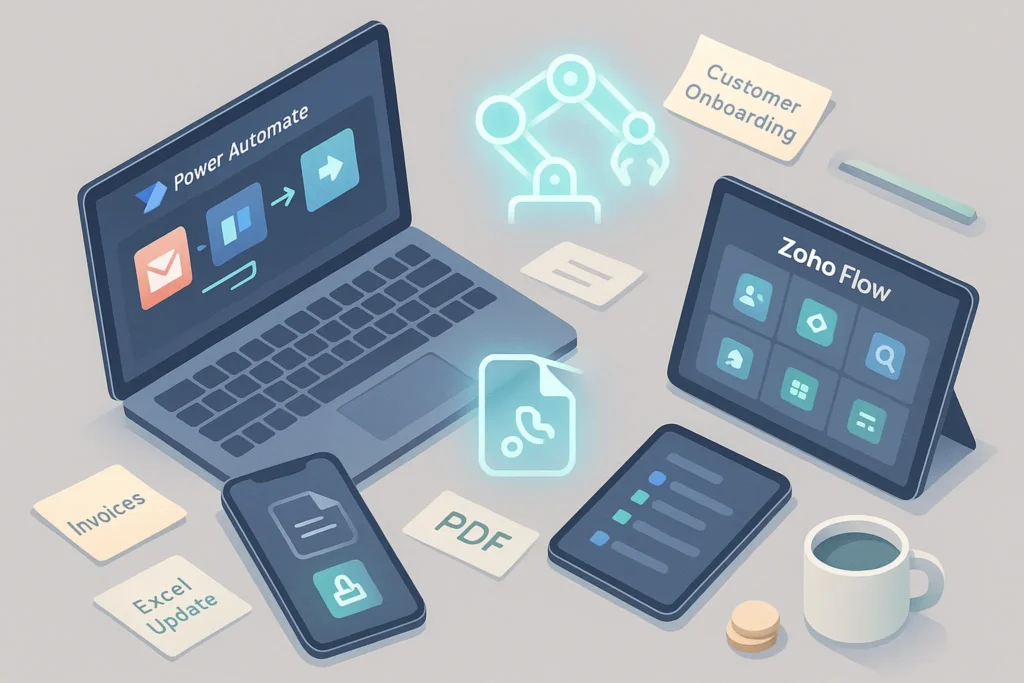-This post may contain affiliate links. If you click on one and make a purchase, I may earn a small commission at no extra cost to you.-
🤖 Introduction: What is RPA (Robotic Process Automation) and Why It Matters in 2025
In the past, robotic process automation (RPA) was something only big enterprises could afford. But in 2025, tools like Microsoft Power Automate, Make, and Zoho Flow have brought automation into the hands of small business owners and solopreneurs. Think of RPA as a “digital worker” that handles repetitive tasks—like extracting data from PDFs or updating spreadsheets—without you lifting a finger.
At its core, RPA is software that mimics human actions—like copying data, filling out forms, or moving files between apps. The difference? It never gets tired, bored, or distracted.
And unlike simpler workflow automation tools used by solopreneurs such as Zapier or Make, RPA operates on a deeper level—handling UI interactions, structured documents, and logic-heavy tasks.
If you’re a small business owner juggling sales, admin, customer support, and finance, automation isn’t just a luxury—it’s survival. And RPA is your next hire.
🧰 Real-World Use Cases of RPA for Small Teams (2–10 People)
Let’s break it down by profession and show you exactly how RPA can make life easier:
🛒 For E-commerce Stores
Use Case: Automate inventory updates between Shopify and an internal Google Sheet using Power Automate. Add a bot to track and email low stock alerts.
🧪 Bonus: Add AI sentiment analysis on customer feedback using Microsoft AI Builder + Power Automate.
💰 For Financial Service Firms
Problem: Accountants and tax consultants spend endless hours extracting numbers from PDFs, invoices, and bank statements.
Use Case: Use UiPath or Robocorp to scan incoming invoices, extract totals, and auto-fill your accounting software. Set up rule-based triggers for due date reminders.
RPA Workflow:
Use UiPath or Robocorp to extract structured data (like invoice amount, due date, vendor) and input it into QuickBooks or Xero.
Why it matters: You can automate 70% of your document-based workflows—no manual typing, no copy-paste fatigue.
Imagine removing all manual data entry for client billing. That’s hours saved each week.
🧠 Pro Tip: Combine RPA with AI-based tools to flag suspicious entries or duplicates.
🏢 For Real Estate Agents
Problem: Entering property details into CRM, MLS, and spreadsheets takes up half the day.
RPA Workflow:
Use Zoho Flow to connect form submissions with your CRM, listing platforms, and even automated email sequences.
🔍 Micro-comparison: Zapier can handle form > CRM updates, but RPA can open apps, interact with files, and update internal systems.
Use Case: Automatically collect property details from forms and insert them into CRM and MLS platforms using Zoho Flow.
Instead of copying and pasting listings 10 times, let RPA take care of it while you focus on clients.
✍️ For Content Teams and Agencies
Problem: Writers submit content via forms or email; editors manually organize them in folders, update the content calendar, and assign tasks.
Use Case: When a new article draft is submitted via a form, RPA bots can rename, tag, upload, and organize it in your CMS and Google Drive—automatically.
Combine this with editorial calendar updates and Slack alerts. No more chaos in content pipelines.
RPA Workflow:
With Power Automate, auto-create project folders, move files to correct drives, notify editors on Slack, and update Notion board tasks.
🧠 We tested this in-house: Automating our editorial intake saved 3–5 hours per week for a 4-person content team.
🔍 RPA vs Traditional Automation Tools Like Zapier & Make
| Feature | RPA Tools (e.g., UiPath, Robocorp) | Zapier / Make |
|---|---|---|
| Interface | Desktop + Web | Mostly Web |
| Task Type | UI-level actions, complex sequences | API calls, event triggers |
| Best For | Structured, repetitive back-office work | App integrations, event-based triggers |
| Complexity | Higher learning curve | Beginner-friendly |
| Pricing | Variable; often freemium | Freemium, scales with usage |
🧠 Verdict?
-
Zapier or Make = Best for quick “app-to-app” connections
-
RPA = Best when dealing with structured documents, desktop applications, or data-heavy tasks
💡 Smart SMBs in 2025 combine both approaches for full coverage.
🔧 Top RPA Tools Accessible for Small Businesses
Here’s a closer look at RPA platforms that don’t require hiring a developer:
🧠 Microsoft Power Automate – Automate Everything from Outlook to Excel
Microsoft Power Automate (formerly Microsoft Flow) is one of the most accessible and robust automation platforms available—especially for small businesses already using Microsoft 365. Its biggest strength is its seamless integration with tools like Excel, Outlook, SharePoint, and Teams, making it ideal for automating everything from email parsing to calendar updates.
What sets Power Automate apart from simpler automation tools is its Desktop Flows feature, which lets you interact directly with desktop apps—even those without APIs. This means you can automate legacy software, desktop-based Excel files, or internal tools that live outside the browser.
Another powerful feature is AI Builder, which brings machine learning, OCR, and intelligent document processing into your workflows—without writing code. You can automatically extract information from PDFs, process forms, or classify data with just a few clicks.
✅ Real-world example: When a client sends an invoice to your Outlook inbox, Power Automate can extract the amount from the PDF, update a tracking spreadsheet, and send a reminder message to your team in Teams—all automatically.
With hundreds of pre-built templates and deep Microsoft integrations, Power Automate is a low-friction entry point into serious automation for SMBs.
A great entry point if you’re already using Microsoft 365. It has prebuilt connectors, AI Builder integration, and solid desktop flow options.
Part of Microsoft 365 ecosystem. Great for Excel-heavy or Windows-based workflows.
-
Desktop + cloud automation
-
Integrates with SharePoint, Outlook, Teams
-
Includes AI Builder for smart automation
🌐 Zoho Flow – Perfect for Businesses Using the Zoho Suite
Zoho Flow is a visual, no-code automation platform designed specifically for businesses already using the Zoho ecosystem—such as Zoho CRM, Zoho Books, Zoho Projects, and more. It’s lightweight, intuitive, and remarkably powerful for small teams.
The platform allows you to create multi-step workflows (called Flows) using a clean drag-and-drop interface. You can trigger events based on form submissions, CRM updates, or file uploads, then pass data between apps effortlessly.
What makes Zoho Flow ideal for small businesses is the fact that it’s cost-effective, easy to learn, and deeply embedded within Zoho’s broader product suite. It’s especially useful for businesses in consulting, real estate, and service industries who already rely on Zoho tools.
✅ Real-world example: A user fills out a lead form on your website → Zoho Flow adds the contact to your CRM → Automatically generates an invoice in Zoho Books → Sends a confirmation email to the client.
You can also integrate external apps like Google Drive, Slack, Mailchimp, and Trello, making Zoho Flow versatile beyond its native stack.
Ideal for businesses already using Zoho CRM, Zoho Books, or other Zoho tools. It’s affordable and beginner-friendly.
Affordable, visual workflow builder for businesses in the Zoho ecosystem (Zoho CRM, Zoho Books, etc.).
-
Clean UI, quick to learn
-
Excellent internal app connectivity
-
Real-time automation triggers
🧪 Robocorp – Open-Source RPA with Full Developer Control
Robocorp is a unique RPA platform built on an open-source philosophy with a developer-first approach. Instead of offering a point-and-click interface, Robocorp gives teams full control to build bots using Python and the Robot Framework, allowing for more flexible, powerful automations.
It’s perfect for startups or small companies with technical co-founders or developers on board. Robocorp supports everything from document parsing and file handling to API calls and browser automation.
What makes Robocorp stand out is its ability to scale and adapt. You can run bots in the cloud, schedule them, monitor performance, and build extremely custom logic—all while avoiding vendor lock-in.
✅ Real-world example: A financial consultant uses Robocorp to extract monthly invoice totals from dozens of PDFs, clean and format the data, and export it to Google Sheets with summary totals—saving hours every week.
If your team has even light Python knowledge, Robocorp offers power and flexibility that no no-code platform can match.
Open-source RPA with Python scripting. Ideal for startups with technical co-founders or dev help.
-
Full control over bots
-
Desktop-friendly
-
Can handle PDF-to-Excel workflows flawlessly
⚠️ Not for beginners—but great for power users.
An open-source RPA platform with a focus on Python workflows. Great for slightly more technical teams or startups needing flexibility.
🧠 Real Example: Robocorp used in small tax consultancies to generate end-of-year reports automatically.
⚙️ UiPath Community Edition – Enterprise-Grade RPA for Small Teams
UiPath is a global leader in robotic process automation, and its Community Edition brings the same enterprise-level tools to individuals and small teams—completely free.
With UiPath, you can automate both web and desktop applications, use drag-and-drop visual workflows, or take advantage of Recorder Mode to capture and replay UI actions. It’s incredibly powerful for tasks like invoice scanning, form filling, report generation, and desktop automation.
UiPath also includes AI-powered capabilities such as document understanding, OCR, and even computer vision—features typically only found in high-end enterprise platforms.
✅ Real-world example: A small insurance agency uses UiPath to scan and extract data from Excel reports, organize customer info into folders, and automatically email summaries to agents—all without human intervention.
UiPath’s extensive library of templates, active user forums, and free learning academy make it surprisingly beginner-friendly—even for teams with zero automation experience.
Enterprise-grade RPA now free for individuals and small teams.
-
Best for document-heavy businesses
-
Includes process recorder
-
Desktop + browser automation
Example: Small tax firm uses UiPath to extract data from 30+ monthly invoices and generate end-of-month summaries.
One of the most powerful RPA tools on the market—now with a free community edition perfect for solopreneurs to experiment.
📊 Bonus: What Can You Actually Automate with RPA?
Still not sure how RPA fits into your workflow? Here’s a list of real-world repetitive tasks that small businesses can start automating today—without coding.
✅ Invoice Processing: Read invoice PDFs, extract totals, and update accounting tools
✅ Email Parsing: Scan emails for order details and push them into your CRM
✅ Form-to-Spreadsheet: Move form submissions into formatted Google Sheets or Excel files
✅ File Renaming & Organization: Automatically rename and sort uploaded files
✅ Customer Onboarding: Trigger welcome emails, task assignments, and document generation
✅ Inventory Sync: Match stock numbers across eCommerce platforms and supplier databases
✅ Social Media Archiving: Save inbound DMs or form submissions to your CMS or content queue
Even just automating one of these can save you hours per week. RPA isn’t about replacing people—it’s about removing digital grunt work so your team can focus on what matters.
💬 Real Quote from an SMB Owner
“Once we automated our invoice tracking and document naming process using Power Automate, it was like a weight lifted off our shoulders. We’re just a 4-person agency—but it feels like we hired a fifth team member who never sleeps.”
— Lena H., Founder of PixelPoint Media
🧠 Nerd Verdict
We’ve tested automation tools across dozens of workflows at NerdChips.
Zapier and Make are fantastic for simple web-to-web connections. But if you’re working with files, forms, desktop apps, or document processing, RPA is what you need.
Personally, I’d recommend Power Automate to any small business already using Excel or Outlook—it’s the easiest on-ramp.
If you’re a bit more technical? Robocorp will blow your mind with what’s possible.
2025 is the year small businesses stop wasting time on repetitive tasks—and RPA is how you do it.
Personally, I’d recommend Power Automate to any small business already using Excel or Outlook—it’s the easiest on-ramp. If you’re looking to go even further and let AI assistants manage daily tasks like scheduling or email triage, check out our full guide on AI Automation in 2025 for more inspiration.
Bottom line: In 2025, small teams can finally afford enterprise-grade automation. And those who adopt early? They scale faster, burn out less, and look pro doing it.
❓ FAQ: Nerds Ask, We Answer
Q1: Isn’t RPA too complex for a team of 5?
Not anymore. Platforms like Power Automate and Zoho Flow come with drag-and-drop interfaces. Plus, tons of templates exist for common use cases.
Q2: How much does it cost?
Some tools like Robocorp and Power Automate offer free tiers. Zoho Flow starts at just a few dollars per month.
Q3: Do I need to know coding?
Only if you’re using advanced platforms like Robocorp. Most RPA tools today are no-code or low-code.
Q4: Can I combine RPA with tools like Zapier?
Yes! Use RPA for document workflows and API tools like Make for cloud-to-cloud integrations.
Q5: I only have 3 employees. Do I really need automation like this?
A: Absolutely. In fact, small teams benefit even more from automation because they lack the manpower to do everything manually. RPA helps you scale without hiring, reduces human error, and gives you a competitive edge. Think of it as hiring a digital intern that works 24/7.
Q6: Isn’t RPA expensive or hard to set up?
A: Not anymore. Tools like Power Automate and Zoho Flow offer free tiers, prebuilt templates, and step-by-step guidance. You don’t need a developer to get started.
💬 Would You Bite?
If you could automate one repetitive task in your business right now, what would it be?
Let us know in the comments—we might build a tutorial for it next! 👇



